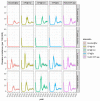Understanding the Role of Duration of Vaccine Protection with MenAfriVac: Simulating Alternative Vaccination Strategies
- PMID: 33672209
- PMCID: PMC7926406
- DOI: 10.3390/microorganisms9020461
Understanding the Role of Duration of Vaccine Protection with MenAfriVac: Simulating Alternative Vaccination Strategies
Abstract
We previously developed a transmission dynamic model of Neisseria meningitidis serogroup A (NmA) with the aim of forecasting the relative benefits of different immunisation strategies with MenAfriVac. Our findings suggested that the most effective strategy in maintaining disease control was the introduction of MenAfriVac into the Expanded Programme on Immunisation (EPI). This strategy is currently being followed by the countries of the meningitis belt. Since then, the persistence of vaccine-induced antibodies has been further studied and new data suggest that immune response is influenced by the age at vaccination. Here, we aim to investigate the influence of both the duration and age-specificity of vaccine-induced protection on our model predictions and explore how the optimal vaccination strategy may change in the long-term. We adapted our previous model and considered plausible alternative immunization strategies, including the addition of a booster dose to the current schedule, as well as the routine vaccination of school-aged children for a range of different assumptions regarding the duration of protection. To allow for a comparison between the different strategies, we use several metrics, including the median age of infection, the number of people needed to vaccinate (NNV) to prevent one case, the age distribution of cases for each strategy, as well as the time it takes for the number of cases to start increasing after the honeymoon period (resurgence). None of the strategies explored in this work is superior in all respects. This is especially true when vaccine-induced protection is the same regardless of the age at vaccination. Uncertainty in the duration of protection is important. For duration of protection lasting for an average of 18 years or longer, the model predicts elimination of NmA cases. Assuming that vaccine protection is more durable for individuals vaccinated after the age of 5 years, routine immunization of older children would be more efficient in reducing disease incidence and would also result in a fewer number of doses necessary to prevent one case. Assuming that elimination does not occur, adding a booster dose is likely to prevent most cases but the caveat will be a more costly intervention. These results can be used to understand important sources of uncertainty around MenAfriVac and support decisions by policymakers.
Keywords: Africa; mathematical modelling; meningitis; vaccine.
Conflict of interest statement
Caroline L. Trotter reports receiving a consulting payment from GlaxoSmithKline in 2018, outside the submitted work. Other authors declare no conflict of interest. The funders had no role in the design of the study; in the collection, analyses, or interpretation of data; in the writing of the manuscript, or in the decision to publish the results.
Figures





Similar articles
-
Modeling Long-term Vaccination Strategies With MenAfriVac in the African Meningitis Belt.Clin Infect Dis. 2015 Nov 15;61 Suppl 5(Suppl 5):S594-600. doi: 10.1093/cid/civ508. Clin Infect Dis. 2015. PMID: 26553693 Free PMC article.
-
Evaluation of meningococcal meningitis vaccination strategies for the meningitis belt in Africa.Pediatr Infect Dis J. 1999 Dec;18(12):1051-9. doi: 10.1097/00006454-199912000-00005. Pediatr Infect Dis J. 1999. PMID: 10608623
-
Emergency vaccination against epidemic meningitis in Ghana: implications for the control of meningococcal disease in West Africa.Lancet. 2000 Jan 1;355(9197):30-3. doi: 10.1016/S0140-6736(99)03366-8. Lancet. 2000. PMID: 10615888
-
Epidemiologic effects of varicella vaccination.Infect Dis Clin North Am. 1996 Sep;10(3):631-55. doi: 10.1016/s0891-5520(05)70318-4. Infect Dis Clin North Am. 1996. PMID: 8856357 Review.
-
Optimizing the timing of 4CMenB vaccination in adolescents and young adults based on immune persistence and booster response data.Expert Rev Vaccines. 2019 Apr;18(4):343-352. doi: 10.1080/14760584.2019.1580579. Epub 2019 Mar 22. Expert Rev Vaccines. 2019. PMID: 30741040 Review.
Cited by
-
Impact of COVID-19-related disruptions to measles, meningococcal A, and yellow fever vaccination in 10 countries.Elife. 2021 Jun 24;10:e67023. doi: 10.7554/eLife.67023. Elife. 2021. PMID: 34165077 Free PMC article.
-
Editorial for the Special Issue: Bacterial Meningitis-Epidemiology and Vaccination.Microorganisms. 2021 Apr 24;9(5):917. doi: 10.3390/microorganisms9050917. Microorganisms. 2021. PMID: 33923323 Free PMC article.
References
-
- Trotter C.L., Lingani C., Fernandez K., Cooper L.V., Bita A., Tevi-Benissan C., Ronveaux O., Marie-Pierre P., Stuart J.M. Impact of MenAfriVac in nine countries of the African meningitis belt, 2010–2015: An analysis of surveillance data. Lancet Infect. Dis. 2017;17:867–872. doi: 10.1016/S1473-3099(17)30301-8. - DOI - PubMed
-
- World Health Organization (WHO) Meningococcal A conjugate vaccine: Updated guidance, February 2015. Wkly. Epidemiol. Rec. 2015;90:57–62. - PubMed
Grants and funding
LinkOut - more resources
Full Text Sources
Other Literature Sources

